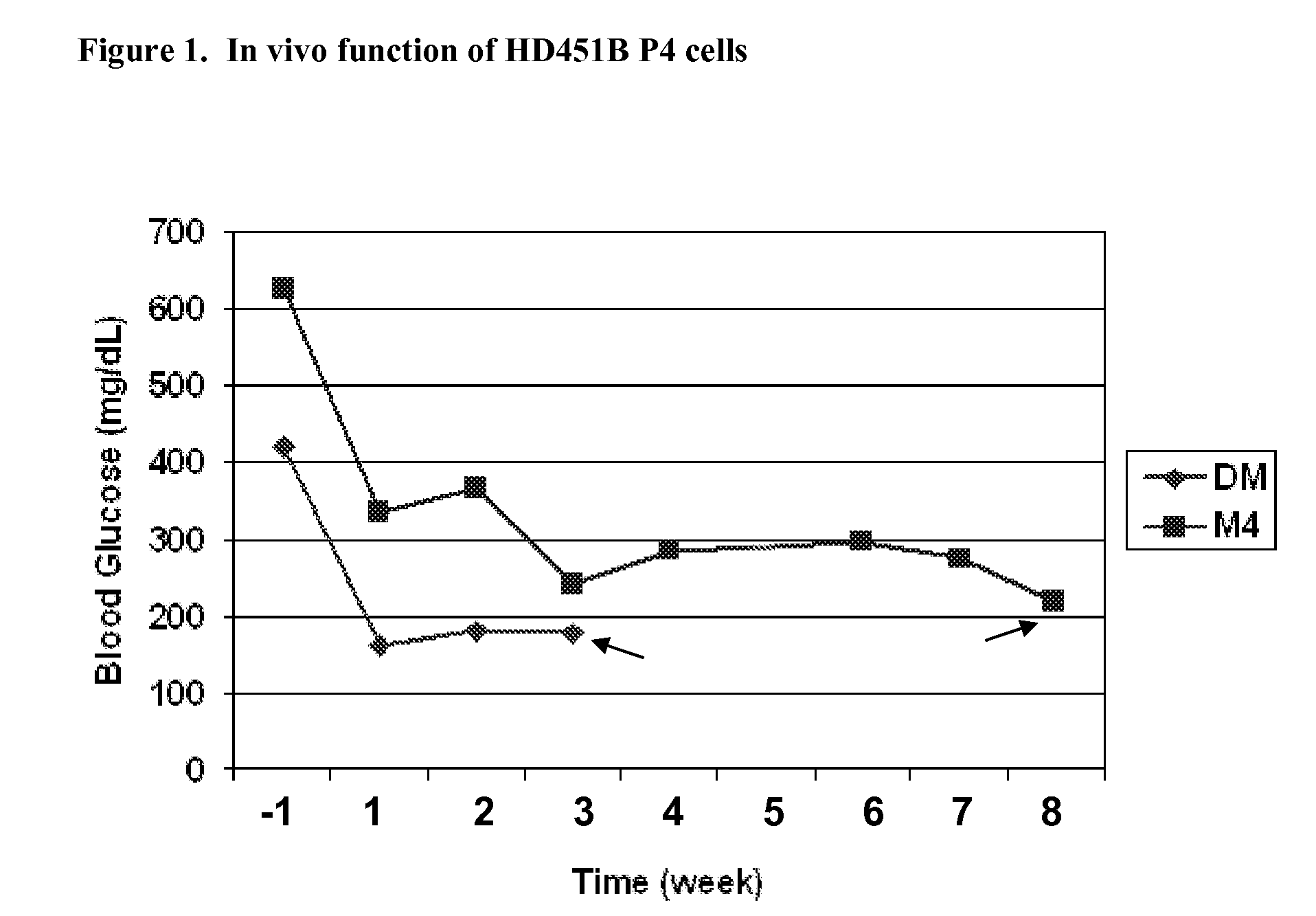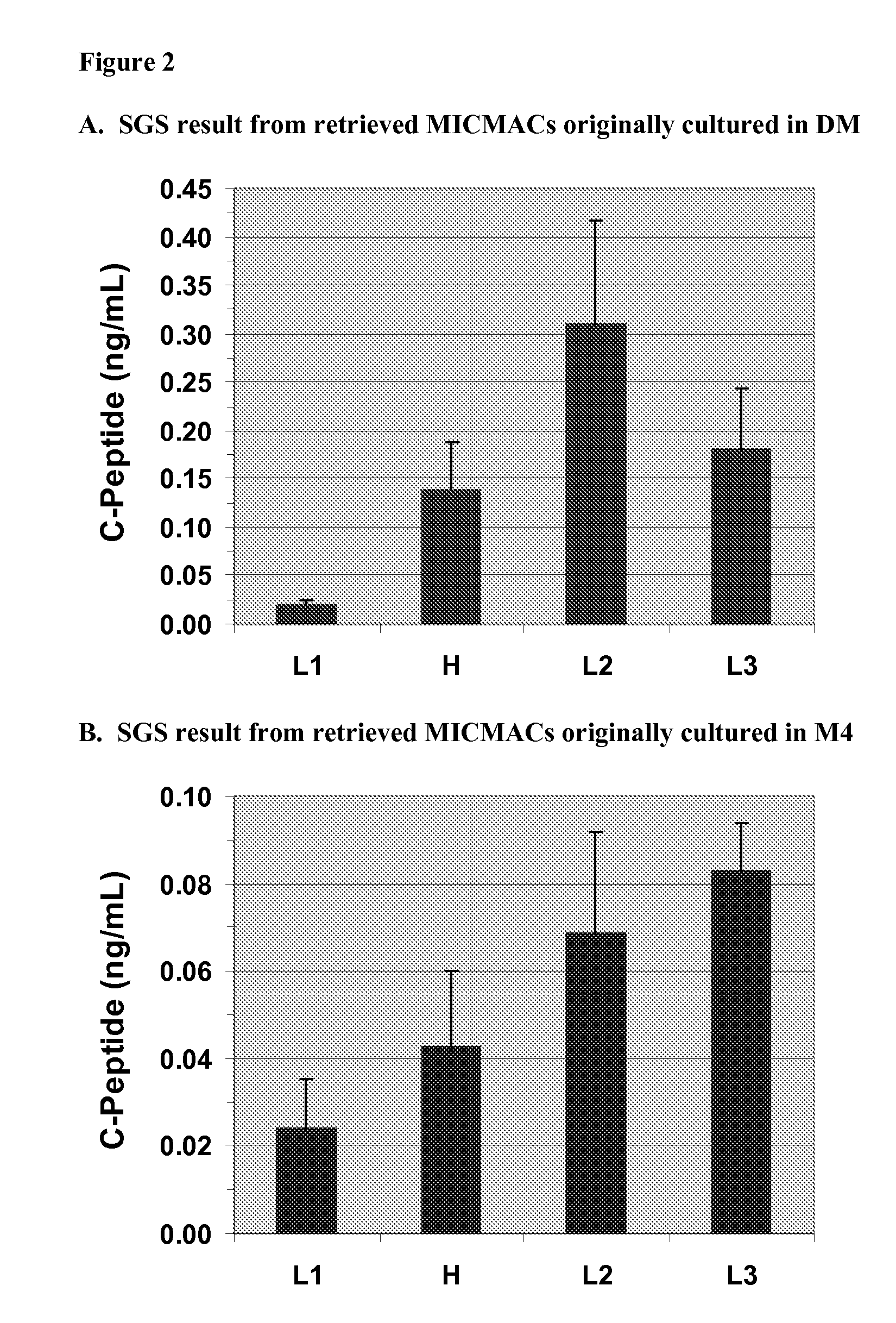Methods of Selecting Pancreatic Endocrine Cells Using Protein Synthesis Inhibitors
a technology of endocrine cells and protein synthesis inhibitors, which is applied in the field of selecting pancreatic endocrine cells using protein synthesis inhibitors, can solve the problems of chronic immunosuppression toxicity, inability to efficiently isolate progenitor cells from donor pancreas, and inability to meet the needs of patients,
- Summary
- Abstract
- Description
- Claims
- Application Information
AI Technical Summary
Problems solved by technology
Method used
Image
Examples
example 1
Selection for Pancreatic Endocrine Cells Using Hygromycin B
[0166] Pancreatic cells were isolated from donor pancreas as described in published US Patent Application No. 20040115805, which is herein incorporated by reference for all purposes.
[0167] Samples of HD437 P0 pancreatic primary cells from prepurified (PP) layer were cultured in chamber slides in M3 media for 2 days. Hygromycin (25 μg / ml) was then added to the medium for 24 hours. The cells were given same treatment after then cultured for six days in medium M3+ (M3 with supplements containing ITS (1:100), leukemia inhibitory factor (LIF) (1000 u / ml), and alphidicolin (2 μg / ml)) for recovery and synchronization and then the hygromycin B treatment was repeated. Three days after the second treatment one set of cells was fixed for immunocytochemistry analysis and the other set was harvested and analyzed by quantitative RT-PCR. A control group received no hygromycin B and was cultured in M3 for 6 days and had to be harvested fo...
example 2
Characterization of Hygromycin B Selected Pancreatic Endocrine Cells
[0168] Expression of NeuroD1, a pancreatic progenitor marker was determined by quantitative RT-PCR in P0 cells from HD437PP and HD438I with or without hygromycin B treatment. The NeuroD1 mRNA was normalized to β-actin mRNA and the expression levels are indicated by the ratio of mRNA of NeuroD1 to β-actin. Table 1 shows the results. Cells that survived after hygromycin B treatment expressed more NeuroD1 especially cells from HD437PP. The cells proliferated after hygromycin B selection, therefore, it is quite possible that the ratio increase is the result of proliferation of CD56 positive cells after hygromycin selection.
[0169] The mRNA expression of endocrine hormones insulin and glucagons in hygromycin B selected cells from HD437PP and HD438I at P0 are similar to the situations for NeuroD1 and PDX-1. Hygromycin B selected cells not only have higher insulin (30- to 49-fold) and glucagons (27- to 117-fold) to β-acti...
example 3
Hygromycin B-Selected, Pancreatic Endocrine Cells can be Expanded
[0177] To determine whether hygromycin B selected cells can be expanded, P1 cells from HD436PP were cultured in SM95 containing 20% M3 medium for 10 days with two medium changes. After reaching confluence, cells were harvested and ⅕ of P1 cells were analyzed by quantitative RT-PCR (Table 5). The remainder were split into four equal portions and passed to P2 in four different conditions. In condition A, cells were seeded in a 6-well culture dish. Cells in two of the wells were seeded and cultured in HJM supplemented with 20 ng / ml bFGF for 9 days and switched to either HJM (P2 d) or SM95 (P2 e) with 10 mM nicotinamide supplementation. The others were seeded in SM95 overnight and switched to one of the following media conditions: B (P2 a); HJM / bFGF(20 ng / ml) Betacellulin (10 ng / ml), C(P2 b); SM95 with 10% M3 for one day then SM95 alone, or D (P2 c); SM95 / bFGF(20 ng / ml) / FGF10 (10 ng / ml). Cells were maintained in the afore...
PUM
 Login to View More
Login to View More Abstract
Description
Claims
Application Information
 Login to View More
Login to View More - R&D
- Intellectual Property
- Life Sciences
- Materials
- Tech Scout
- Unparalleled Data Quality
- Higher Quality Content
- 60% Fewer Hallucinations
Browse by: Latest US Patents, China's latest patents, Technical Efficacy Thesaurus, Application Domain, Technology Topic, Popular Technical Reports.
© 2025 PatSnap. All rights reserved.Legal|Privacy policy|Modern Slavery Act Transparency Statement|Sitemap|About US| Contact US: help@patsnap.com


